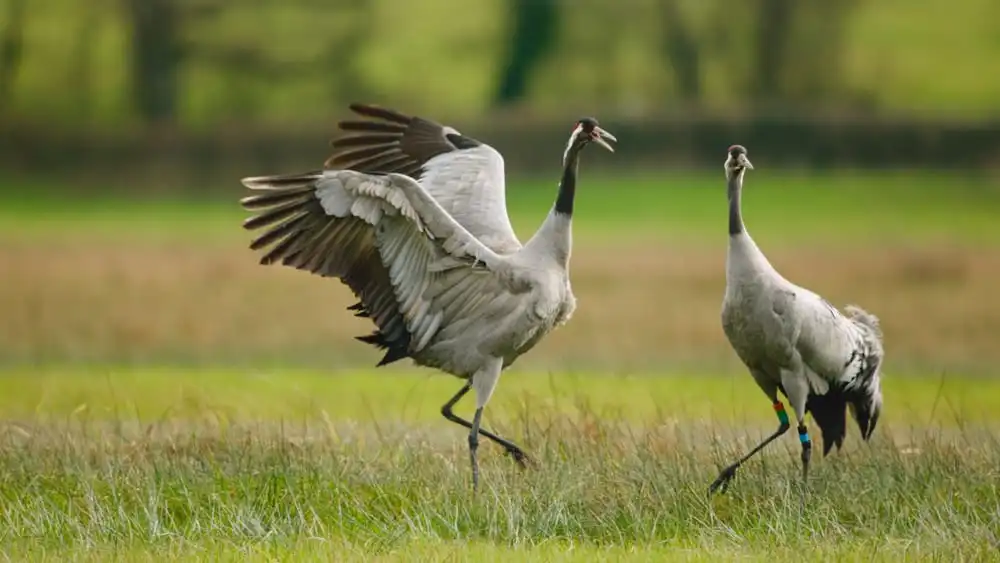Record-Breaking Numbers of Common Cranes in the UK: A Conservation Success Story
The conservation efforts by the Royal Society for the Protection of Birds (RSPB) have led to record-breaking numbers of Common Cranes in the UK, according to the charity’s latest breeding survey. With 30 breeding pairs counted this year, a remarkable 20% increase from the previous highest total of 25 pairs in 2023, the species is showing signs of a strong and positive recovery. This is the highest number of Common Crane pairs seen in the UK since the birds made their return in 1979 after a long absence due to hunting and habitat loss that drove them to extinction in the 16th century. Today, the total UK population stands at approximately 80 pairs.
As the UK’s tallest bird, the Common Crane stands at an impressive 1.2 meters (4 feet). Known for their elegant long legs, necks, and drooping wing feathers, these birds are easily recognizable. Their grey plumage, striking black-and-white head, and the bright splash of red on their crown make them an unforgettable sight. During the breeding season, the adult cranes perform a captivating and graceful courtship dance, characterized by energetic head-bobbing, bows, and pirouettes. Despite their large size, Common Cranes are naturally secretive during this time, and their nests, often hidden among reedbeds, can be difficult to spot.
The successful recovery of the Common Crane population is a testament to the tireless efforts of conservationists and organizations like the RSPB. The protection and restoration of the UK’s wetlands have played a pivotal role in bringing the crane back from the brink of extinction. These wetlands not only offer essential habitats for cranes but also help mitigate the effects of climate change and flooding. More than 80% of the UK’s breeding population of Common Cranes can now be found in protected sites, with over a third of those residing on RSPB nature reserves alone.

One of the major factors contributing to this resurgence is the reintroduction of cranes in the southwest of England. The addition of new habitats, including sites such as RSPB West Sedgemoor and RSPB Greylake in Somerset, has played a significant role in supporting the growing crane population. At West Sedgemoor, the number of breeding pairs has increased from 12 to 14, while Greylake saw an increase from 1 to 3 pairs.
A particularly exciting development this year was the successful nesting of the first pair of Common Cranes at RSPB Ham Wall, also in Somerset. Thanks to reedbed management, which provided ideal nesting cover, a single chick was successfully raised and fledged — marking a first for the reserve in 2024. Looking ahead, the reserve’s team plans to enhance nearby marshy grassland to further increase the chances of successful nesting. Creating scrapes, pools, and ditches will provide extra feeding habitat for cranes and other species like herons and egrets.
RSPB Lakenheath Fen in Suffolk has also played a significant role in crane conservation. By creating “runways” for cranes, large areas of reedbed are cut during winter to allow the cranes to safely land and take off near their nest sites without their wings getting caught in the reeds. This innovative method, which mimics airport runways, helped three crane pairs nest successfully and fledge three chicks—an incredible result after the species’ extinction as a British breeding bird.

Dave Rogers, the Site Manager at RSPB Lakenheath Fen, expressed his excitement about the increasing crane numbers: “It is fantastic to see Crane numbers increasing on RSPB nature reserves – thanks to the hard work of staff to create safe havens for this iconic species. The growing Crane population shows effective conservation by organisations, landowners, and volunteers in action. It is a shining example that nature can thrive when given a chance.”
While Common Cranes are still considered a rare bird in the UK, their increasing numbers are a sign of hope. Across England and Scotland, visitors to RSPB nature reserves like West Sedgemoor, Greylake, Lakenheath Fen, Ham Wall, the Nene Washes, and Loch of Strathbeg now have the chance to spot these magnificent birds.
The importance of monitoring crane numbers, along with other species, cannot be overstated in conservation efforts. The collaboration between the RSPB, landowners, volunteers, and the general public has proven vital in ensuring the success of these initiatives. Volunteers, in particular, play a crucial role in conservation, and the RSPB is proud to have over 13,000 volunteers across the UK who dedicate their time to make a positive impact on nature and the environment.
The increasing crane population is not only a success for the species but also highlights the importance of wetland conservation. These habitats play a crucial role in supporting countless species, locking away carbon, and reducing the risk of flooding. With this in mind, the RSPB continues to urge policymakers and government officials to recognize the critical role of wetlands in both biodiversity conservation and combating the climate and nature crises.
In conclusion, the remarkable rise in Common Crane numbers in the UK is a testament to the power of effective conservation and habitat restoration. It’s a shining example of how concerted efforts can bring a species back from the brink of extinction, providing hope for future generations of both cranes and the ecosystems they inhabit. As more cranes hatch and fledge each year, the RSPB and its partners remain committed to ensuring these majestic birds continue to thrive for years to come.
